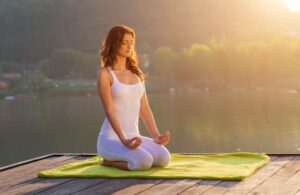Yin yoga https://www.julianalucky.com/post/mommy-and-me-yoga-benefits, like classes in other styles, requires concentration and correct technique. If you neglect the instructions, even during such a soft and passive practice, there is a risk of injury.
Important! Yin yoga is not a therapeutic method. Like hatha yoga, it is for healthy people. Do not try to restore the function of damaged tissues or joints with this practice, especially from videos on the net, even if the author presents the complex as “yin yoga exercises for the back.” If you have an injury or chronic illness, it is recommended that you consult with a doctor or yoga therapist before starting a yoga practice.
Training
Before practicing Yin Yoga, it is advisable to pause for at least 2 hours after eating.
Ventilate the room thoroughly and prepare warm clothes. Since the practice does not involve warming up, you may need warm socks, a blanket or outerwear. Turn off your phone and put the necessary equipment nearby: bricks, a roller and / or a bolster to relieve the situation. The less distractions you have during the practice, the better.
Before starting, formulate an intention for practice. It will support you in the process and fill it with meaning.
Practice
1. Accept the body position given by the instructor, adapting it to your physical capabilities.
The posture should be relaxed and comfortable! Do not try to go as deep as possible – there is no such task, the effectiveness of the practice will not increase from this, rather, on the contrary.
Find a balance: the asana should be kept on the border of mild discomfort. You should feel some tension and resistance, but not pain from the tension created in your body.
Do not strive for the ideal geometry of the asana and for the exact adjustments that you are used to during yang practice. On the contrary, try to let go of muscle control and accumulated movement patterns.
2. Tune in to maintaining peace and stillness in the asana.
Having reached your physiological limit in a given form, you freeze in a state of rest and observe the responses of the body and the reactions of the mind, while maintaining complete stillness.
In the practice of yin yoga, three components of peace are distinguished:
Peace of the body. The body is like a majestic mountain, just as natural and motionless. In this state, the muscles do not contract and do not resist gravity, which allows you to achieve a deep impact on the connective tissue.
Peace of breath. Breathing becomes calm, quiet, soft, barely perceptible. For the purpose of concentration, you can use the hissing breath of Ujjayi, if it is familiar to you, does not cause discomfort and has a meditative effect. At the moment of exhalation, direct your attention to the zone of greatest tension in order to release it.
Peace of mind. The state of consciousness directly depends on the quality of breathing: if it is calm and measured, consciousness will follow it, and you will be able to disconnect from the fuss of thoughts and immerse yourself in observation.
Important! If you feel severe pain, do not endure and get out of the situation. Next time, don’t go so deep into it.
3. Stay in the asana for the required time. To influence the Yin tissues, the optimal time to hold the position is from 2 to 20 minutes, depending on the condition and experience of the practitioner. The holding time for different asanas is also different.
Despite the fact that the session seems passive, it is also important to complete it with shavasana.
If you do the practice in the morning or during the day, try to move into everyday activities smoothly, start with more measured activities, and not immediately take on the most labor-intensive plans. This will help to maintain the accumulated state and concentration for a longer time.